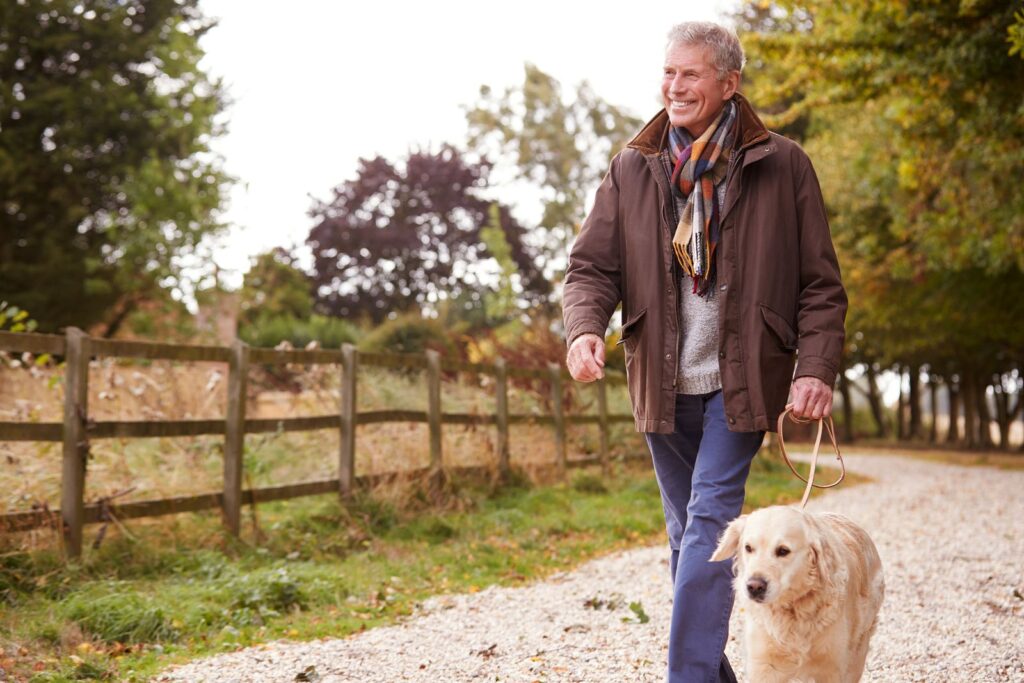
Let’s Get Physical… by Walking
Whether a physical fitness enthusiast or someone who prefers a less active lifestyle, it’s important to keep your body moving on a regular basis… especially as you hit the “seasoned times” of life. According to the National Institute on Aging, regular aerobic activity provides many welcome health benefits as we get older and can be key to healthy, independent living.
The really good news for even the least sports-minded among us is that moving and exercising the body does not have to mean long, vigorous workouts. Taking a walk around the block every day is a great low impact, low-exertion form of physical activity that builds strength, energy, and stamina and fits into almost anyone’s lifestyle.
Walking is a practical, convenient and pleasant way to keep moving. You can take a walk whenever you feel like it, and you can walk at your own pace. As you walk, you can enjoy the fresh air and check out the scenery. You can listen to music or an audio book. You can turn a walk into a social event by walking with a friend or a group of people.
Beginning a walking program can take a little getting used to, of course, especially if you haven’t exercised regularly in a while. But, walking usually becomes easier and more fun you continue walking on a consistent basis.
Beginning a walking routine may cause some minor discomfort in your muscles and joints at first, but any discomfort should pass once your body gets used to the activity. Make sure to seek medical attention if you experience significant pain and/or discomfort that doesn’t ease up. There could be an underlying physical or medical cause that needs to be addressed.
The most important thing about beginning and continuing any exercise program is to execute it wisely and safely. Here are some helpful tips about walking as a regular form of exercise.
Beginner Walking Tips
- Be sensible and realistic. Tailor your walking program to your own personal health status and abilities. Begin slowly. Don’t start out with overly ambitious expectations for yourself. Be reasonable and cautious as you gradually increase your energy output and the length of time you walk. Many resources recommend walking at least 30 minutes a day, but that does not mean you have to walk 30 minutes at a stretch right off the bat. You can walk for 10 minutes three times a day. Then, if you want to, you can gradually build up to a single 30-minute walk.
- Plan your walking routes in advance. It’s always wise to know where you’re going when you head out for a walk. It’s a good idea to map out your route before leaving home. Being familiar with your route can keep you from getting lost, which is no fun at any age. Mixing up your routes can help keep you from getting bored, while giving you different things to observe and experience as you walk. It’s best to start out on a flat, firm surface, especially if you’re a beginner or have some physical limitations. The terrain should fit your age and fitness level.
- Be prepared. Check the local weather forecast so you know what to expect. Wear loose, comfortable clothing and dress in layers so you can add or remove pieces as needed. Make sure your footwear is right for walking. A pair of properly fitted, sturdy walking shoes can offer the right amount of support as you walk. Bring along water to make sure you stay well-hydrated throughout your walk. If you’re walking during the day, make sure to protect yourself from the sun by using plenty of sunscreen and wearing a hat as well as sunglasses. If you’re walking in the evening, make sure you will be visible to drivers by wearing clothing or accessories with reflective materials. Carry a flashlight so you can clearly see the area and any potential dangers.
- Warm up before walking. Warming up before heading out on a walk is important because it prepares your muscles, joints, and the rest of your body for the walk. Stretch and move around a bit. Some light exercise before walking loosens up your body, which helps with balance and flexibility. It can help prevent injury. It also protects your heart, because it slowly elevates your heart rate. Warming up can actually make walking feel easier and less taxing.
- Use roadway logic. If you’re walking along streets, try to keep to those with sidewalks. If there are no sidewalks in places along your route, try to stay on a smooth, stable surface and walk facing oncoming traffic so you and drivers can see each other. When crossing a street, be diligent about stopping to look for traffic coming from both directions. It can be difficult for many of us in our “seasoned” years to turn just our necks and shoulders so it is always a good idea to turn your whole body when looking for traffic. Always wait for a substantial opening in traffic that gives you more than enough time to cross safely. Never take it for granted that cars will definitely stop when you are crossing within a designated pedestrian crosswalk. Wait to be sure the driver sees you.
- Make walking a regular part of your daily life. Walking does not have to be a large scale or elaborate event. Think about all the places and things you already do that involve walking. Next time you go to the mall or visit a museum, spend a little extra time walking around the facility. Next time you take a bus or subway, get off at the stop before your destination and walk the last leg of your journey. If you’re visiting a friend or loved one who lives nearby, walk over instead of driving.
- Turn walking into a fun adventure. Do whatever you can to make walking a joy rather than a chore. The more you enjoy the experience of walking, the more you will want to partake. There are so many ways to incorporate some fun into walking. You can birdwatch, count the houses or cars along your route, listen to interesting audiobooks or music you love, chat with fellow walkers, think about treasured memories from the past, or make plans for creating future memories, etc.
- Cool down at the end of your walk. Cooling down after a walk – instead of stopping abruptly – is important because it allows your heart rate to slow down gradually, which can prevent dizziness and even fainting. You can cool down by continuing to walk while slowing down your pace. Your doctor may suggest some warm up and cool down routines well-suited to your health, physical condition, and abilities.
- Speak with your doctor. As with any new fitness program, it’s important to check in with your doctor before incorporating a regular schedule of walking into your life. Your doctor will be able to help you create a walking program appropriate to your health status and abilities. He or she may have helpful suggestions for you, such as the right kind of shoes to wear, local areas best suited for walking, or organized walking clubs based in the community.


Age Adds Flavor
We are not old, we are seasoned!
Don’t forget to visit us on FACEBOOK!
